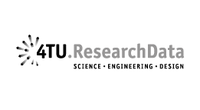Being a certified repository has several external and internal benefits. For instance, it improves the quality and transparency of internal processes, increases awareness of and compliance with established standards, builds stakeholder confidence, enhances the reputation of the repository, and demonstrates that the repository is following good practices. | Dillo & de Leeuw, 2018
A digital archive can be approved by third parties and thus acquire a data quality seal. Such a seal indicates that, according to third parties, the archive is a Trusted Digital Repository (TDR) and that the research data that have been deposited are future proof. In this section, various available data quality seals are discussed.
Data quality seals
CoreTrustSeal (CTS, n.d.a.) is a data quality seal which combines the efforts from the former Data Seal of Approval (DSA) (CTS, n.d.b.) and the World Data System (WDS) (ISCU, n.d.). The CTS is based on the so-called OAIS model. There are 17 guidelines that the archive must demonstrably comply with. This involves describing and documenting work processes such as the approach to software, hardware and data migration.
The DANS data archive contains a dataset with all the institutions that currently have a CTS seal and the associated documentation to prove it (de Leeuw, 2019). A list of certified data archives can be found on the website of CoreTrustSeal (CTS, n.d.d).
In addition to the CTS basic certification, there are two other more extensive standards:
- The NESTOR Seal (NESTOR, n.d.);
- The ISO-certification 16363:2012 (ISO, 2017).

In the spotlight
CTS, NESTOR and ISO: the differences
The table below shows the differences between the CTS certification, the application for the NESTOR seal and ISO certification (Netwerk Digitaal Erfgoed, n.d.). The assessment varies in intensity from a 'peer review' of delivered documentation in the case of the CoreTrustSeal to a prepared 'on-site' visit by an external audit team in the case of the ISO guideline 16363.
Seal | Criteria | Approach |
| CoreTrustSeal | 16 | Review of the self-assessment by two reviewers |
| NESTOR (gebaseerd opDIN 31644) | 34 | Two independent peer reviews |
| ISO 16363 | 109 | Review of the documentation and an on-site audit |
The advantages of a CoreTrustSeal application
Dillo & de Leeuw (2018) summarise a number of the benefits as follows:
- Performing a self-assessment does not take much time; on average two to four days;
- The time to be spent mainly depends on the level of existing documentation;
- The certification process is very useful as an evaluation of internal procedures, which can be reviewed and updated as necessary. The current state of affairs becomes visible. In addition, the procedures and documentation are evaluated, tested and approved by an external professional and the CTS is very useful in identifying strengths and weaknesses;
- CTS certification confirms the usefulness and necessity of long-term planning and helps to put these issues higher on the management's agenda;
- CTS certification contributes to a reliable image. The label clarifies what a digital repository is, what its activities are and creates transparency in the area of sustainability;
- The CTS label helps to build a community: "We all work according to the same standards";
- Because of its general approach, CTS is seen as a less 'threatening', detailed and time-consuming procedure than more comprehensive standards, such as ISO. The focus is on increasing awareness and transparency.
CTS as a starting point for a FAIR data quality seal
In the report 'Turning FAIR into reality', the authors recommend using the CTS as a starting point for the development of an assessment framework for FAIR certification of data archives and services (European Commission, 2018). In the project FAIRsFAIR (n.d.) this recommendation will be elaborated.

Sources
Click to open/close
4TU.Center for Research Data (n.d.) About 4TU.Centre for Research Data. https://researchdata.4tu.nl/en/about-4turesearchdata/organisation/
CoreTrustSeal (n.d.a.). CoreTrustSeal. https://www.coretrustseal.org/
CoreTrustSeal (n.d.b.). Data Seal of Approval Synopsis. https://www.coretrustseal.org/about/history/data-seal-of-approval/
CoreTrustSeal (n.d.c.). Data Repositories Requirements. https://www.coretrustseal.org/why-certification/requirements/
CoreTrustSeal (n.d.d.). Certified Repositories. https://www.coretrustseal.org/why-certification/certified-repositories/
CCSDS. (2012). Reference Model for an Open Archival Information System (OAIS). https://public.ccsds.org/pubs/650x0m2.pdf
Dillo, I., Leeuw, L. de (DANS) (2018). Mitteilungen der VÖB 71. Nr. 1: Repositorien in Österreich. 162-170. http://eprints.rclis.org/34431/1/1981-7410-1-PB.pdf
Europese Commissie (2018). Turning FAIR into reality. https://ec.europa.eu/info/sites/info/files/turning_fair_into_reality_1.pdf
FAIRsFAIR (n.d.). https://www.fairsfair.eu/
ISO (2017). ISO 16363:2012 [CCSDS 652.0-R-1]. SPACE DATA AND INFORMATION TRANSFER SYSTEMS -- AUDIT AND CERTIFICATION OF TRUSTWORTHY DIGITAL REPOSITORIES. https://www.iso.org/standard/56510.html
Leeuw, L. de (DANS) (2019): Data Seal of Approval (DSA). https://doi.org/10.17026/dans-28z-njxq
Nestor (n.d.) https://www.langzeitarchivierung.de/Webs/nestor/DE/Home/home_node.html
Netwerk Digitaal Erfgoed (n.d.). Van zelfevaluatie tot ISO-certificering. Leren Preserveren [cursus]. https://lerenpreserveren.nl/topic/de-vijf-fasen-van-certificering/
Waterman, K., Sierman. B. (2016). Survey on DSA-certified digital repositories. http://www.ncdd.nl/wp-content/uploads/2016/10/201611_DE_Houdbaar_Report_DSA-survey_2016.pdf
World Data System (n.d.) https://www.icsu-wds.org/





